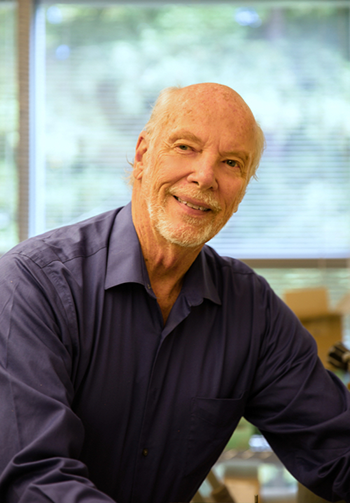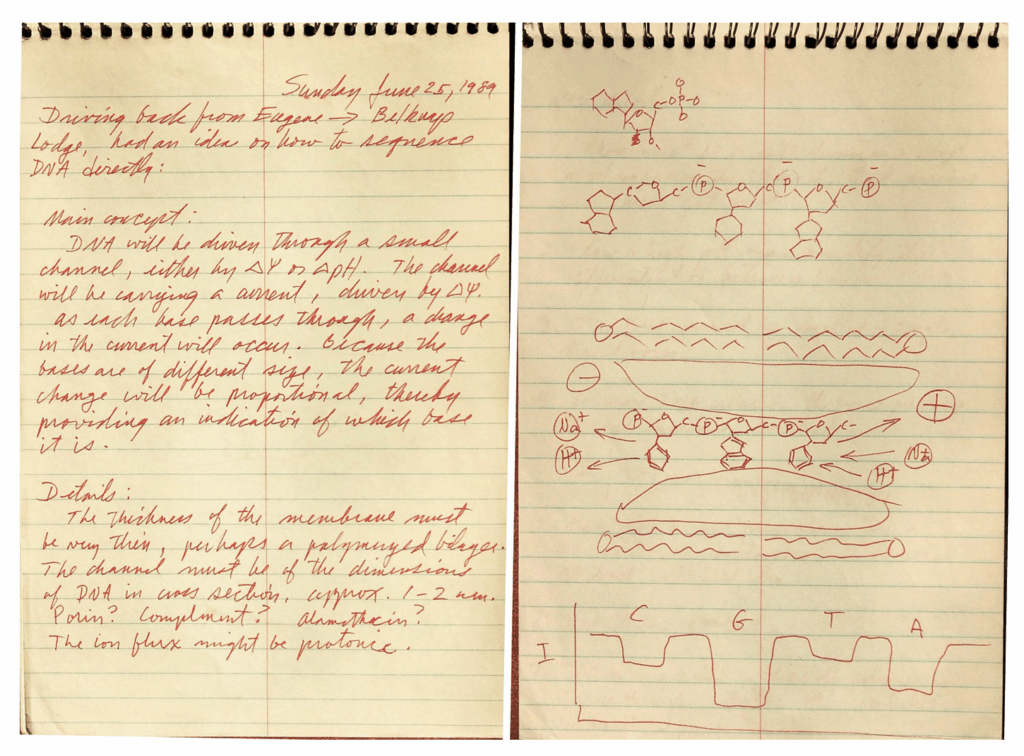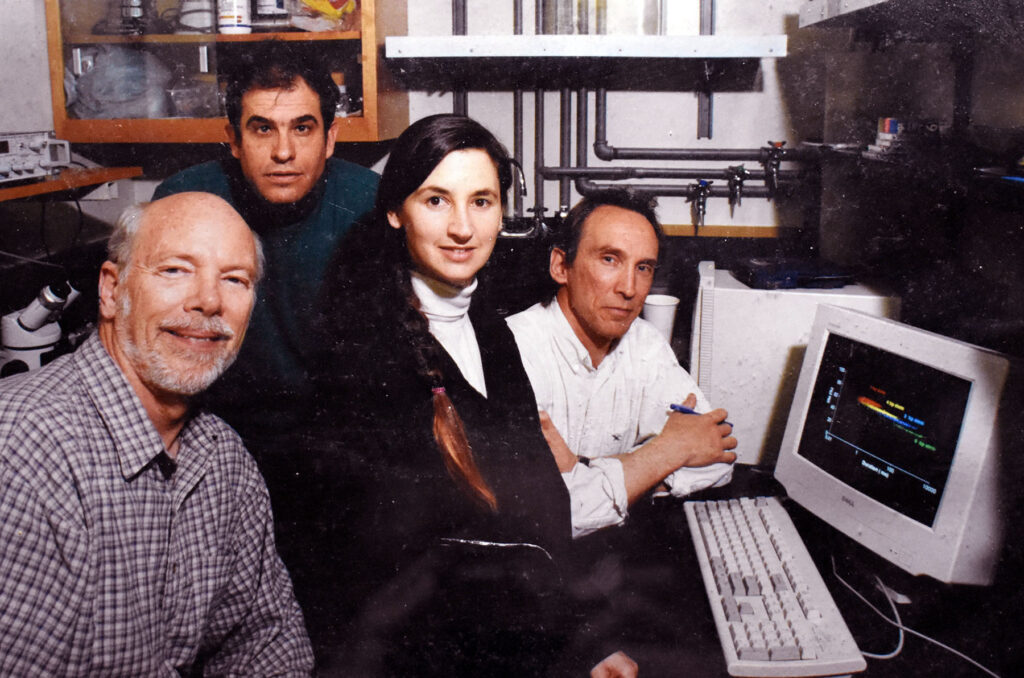Campus News
From concept to commercialization: how UCSC researchers revolutionized DNA sequencing
More than a quarter century since the first patents were filed, the UCSC researchers who pioneered nanopore sequencing reflect on the impact of their invention

It’s a story UC Santa Cruz Research Professor David Deamer has told many times before: in 1989, while driving along a forested road in Oregon on his way to visit family, an idea struck him. Like many other novel scientific concepts, this one came as a convergence of facts, an accumulation of already scientifically established truths that, when combined, led to the creation of a technology transformational to how we understand our own human DNA.
At the time, Deamer was a professor at UC Davis. His research was focused on creating an artificial cell by trapping nucleic acid, the material that makes DNA and RNA, inside of a vesicle made of a double layer of lipids, similar to the membrane which encapsulates living cells.
He had pioneered methods to create small channels in the layers of a membrane to allow an ionic current to flow through. He also knew of a technology called a Coulter counter, a method for counting the red blood cells by running a current through a hole in a membrane just big enough to accommodate a red blood cell, and seeing when that current was disturbed, indicating that a red cell had passed through.
As he drove along with this knowledge humming in the back of his mind, he pondered the central problem he faced in making artificial cells: how he could get the molecules that make up nucleic acid through a membrane layer, which was nearly impermeable to material of that size. In thinking about this challenge, he realized that a tiny, naturally-occurring pore in the membrane might let the molecules pass through. This led him to think that if he ran an ionic current through the pore, he would essentially have a molecular Coulter counter, as the molecules passing through the pore would create an observable effect on the current.
Then, it really hit him: the four bases of DNA and RNA – A, C, G, and T or U – are slightly different sizes. So, if he pulled a string of DNA floating in solution through that hole, each one would have a base-specific effect on the current, which could be translated to read the bases. Deamer pulled to the side of the road at that moment, scrawling in red ink the original concept for nanopore sequencing, a novel and revolutionary method of reading DNA and RNA. The name references the size of the pore, which would end up being just two nanometers across – a sheet of paper is about 100,000 nanometers thick.

It took years of research, persistence, and support to combat skepticism from the scientific community and bring the technology to where it is today. The ideas, licensed to Oxford Nanopore Technologies as patents, led to the development of the revolutionary MinION, a small, portable device that uses a nanopore to read DNA and RNA at a fraction of the cost of the state-of-the-art competitors, making sequencing accessible for scientists around the world. To date, these licenses have become the most lucrative invention out of UCSC.
Nanopore technology has enabled some of the most significant advances in the genomics field, such as the completion of a gapless human genome. Many of the sequenced COVID-19 genomes globally used nanopore sequencing, making it crucial in the fight to stop the pandemic. And now, scientists continue to create innovative ways to use the technology, from gaining a deeper understanding of the origins of life on Earth to searching for life in outer space.
Initial experiments and years of work
It wasn’t until a few years after the original idea struck that nanopore sequencing research really got underway. In 1994, Deamer moved to join his wife and professor of biochemistry Ólöf Einarsdóttir at UC Santa Cruz, where he became a research professor. Around the same time, he decided to pursue a patent for his idea in collaboration with his longtime friend and Harvard professor Dan Branton, who had been Deamer’s post-doctoral advisor when the two were both at UC Berkeley in the 1960s.
After submitting their patent through the Harvard patent office, they were told that another researcher, prominent Harvard geneticist George Church, just happened to be working on a similar idea to pump DNA through a nanoscopic pore – although with little success at the time.
Meanwhile, Deamer and Branton’s initial experiments in the labs of UCSC and Harvard were proving fruitful. By the time they submitted their patents, they had collaborated with National Institute of Standards and Technology (NIST) scientist John Kasianowicz to successfully move nucleic acids through a pore in a membrane. Deamer and Branton decided to team up with Church as named inventors on the patents, and shortly after won a grant from the National Science Foundation supporting two years of research.
By that time, the group had gathered momentum: they wrote a seminal, decisive paper on the technology in 1996 that has since been cited thousands of times, officially got patent rights on their idea in 1998, and won another NIH grant. Their paper convinced another talented scientist to join the team: Mark Akeson, Deamer’s former postdoc student, moved his family out to Santa Cruz.
“I, at first, didn’t believe it was going to work,” Akeson said. “And then lo and behold, Dave and his colleagues at NIST went on to prove that translocation through a nanopore actually happens. That was the most pivotal early experiment that led the way to me coming to Santa Cruz.”
Akeson took an unusual career path to end up as one of the foremost scientists developing nanopore technology. During his undergraduate years at UC San Diego, he majored in history with a minor in molecular biology, and then spent many years in Central America working on agricultural development projects while also a graduate student at UC Davis studying soil microbiology. It was during his time at Davis that he met Deamer, and the two quickly hit it off, forming the connection that led Deamer to invite Akeson to join the nanopore work after spending several years as a research scientist at the NIH.
Akeson joined the nanopore group to study the molecular biology processes that would enable the technology, and was tasked to set up the original nanopore device in their Baskin School of Engineering lab.
Deamer and Akeson gained their first graduate student when Wenonah Vercoutere, the first in her family to pursue graduate school with a dream of working for NASA, joined the research group. Although she originally joined to pursue Deamer’s other research projects, she was quickly brought in to help Akeson with his experiments.
In a paper published in 2001 with Vercoutere as the first author, the group was able to prove that the individual bases could indeed be distinguished from each other as they impeded the ionic current through the nanometer pore in alpha-hemolysin, a toxic protein secreted by bacteria called Staphylococcus aureus.
“That paper finally convinced a bunch of skeptical people that we knew what we were doing, because it clearly showed that we can see a piece of DNA get into the pore as a double stranded hairpin, unwind in the pore and proceed on through,” Deamer said. “That was just spectacular – we were watching individual molecules do this little trick in the pore. Finally we broke through some of the skepticism, because nobody could believe, at the time, that this might work.”
With the help of UCSC Genomics Institute Director David Haussler and his graduate student Stephen Winters-Hilt, the team developed computer learning methods to automate the translation of the ionic current impediments into the base composition of DNA. This effort was a precursor for the leadership role of UCSC and later the Genomics Institute in bioinformatics.
“It was really pretty amazing to be at that place, doing that work, and having those kinds of findings,” said Vercoutere, who is now a research scientist at NASA Ames Research Center.

The early UCSC nanopore group: Deamer (left), Hugh Olsen, Vercoutere, and Akeson.
There were two main challenges the scientists now faced: they needed a pore with sufficient constriction to allow just a few bases at a time to be detected and identified, and a way to slow the DNA down as it moved through the pore. Originally, translocation of DNA through the pore was happening at a rate of two microseconds (two millionths of a second) per base, and it needed to be on the millisecond (one thousandth of a second) time scale, a thousand times.
Akeson pioneered the solution to the second challenge when he discovered the first enzyme, a polymerase, that could latch on to the DNA strand and slow down its movement. A few years later, an NIH-funded project to sequence a human genome for just $1,000 attracted many scientists to the field, including another crucial contributor to the development of nanopore sequencing. Jens Gundlach from the University of Washington joined the team around that time, and solved the first problem when he discovered a better pore to string DNA through, and quickly filed a patent for that idea with his university.
“It was a struggle at times,” Akeson said. “There were a lot of people, like I was initially, who were very skeptical. It took a lot of setbacks and experiments by very talented Santa Cruz scientists to make it work.”
Deamer recounts that a colleague at the NIH told him that at one point, to pass through a multi-step review process to gain research funding, two nobel laureates were brought in to determine if any physical laws would prevent the technology from being possible.
“Bless their hearts, they said ‘No, there’s no physical law, everything is kosher in terms of the physics, it might work!’” Deamer said. “Suddenly, we had a few million dollars in the bank to spend.”
Oxford Nanopore Technologies
In 2007, two men in posh, bespoke English suits, Gordon Sanghera and Spike Willcocks, strolled through the forested UCSC campus, on their way to pay a visit to Akeson and Deamer. They wanted to license several of the patents related to nanopore sequencing with the hope of commercializing the technology through their new company, Oxford Nanopore Technologies (ONT).
“I’ve learned a lesson: if you can patent something, you better do it,” Deamer said with a chuckle.
Although technically just a formality because the university held the patents, Deamer and Akeson gave permission for ONT to use their ideas, and the two researchers joined the company on its scientific advisory board. They had previously pitched their idea to other companies without success, and now, industry was coming to them.
With renowned Oxford biochemist Hagan Bayley as a founder, ONT set off to overcome a series of challenges to bring a product to market. Meanwhile, Deamer and Akeson continued their research in collaboration with Gundlach. Then, in 2012, ONT revealed the product of their years of work at the American Genomics Biotechnology Meeting in Naples, Florida.
“It’s kind of the rock-and-roll DNA technology meeting of the year,” Akeson said. “People love to go there because it’s very festive, people have a great time, and they talk about DNA.”
Amidst the celebratory atmosphere, ONT’s Chief Technology Officer Clive Brown gave the scientists another thing to be excited about. In a historic moment, he held up a Nokia cell phone-sized, handheld device to sequence DNA – competing technology was the size of a large refrigerator – which could be plugged into a laptop and cost just $1,000. He called it the MinION.
“The competing devices were $100,000 and up,” Deamer said. “This is what is meant by disruptive technology, and this is why major companies, recognizing the threat, will try to put the little company out of business. We stunned the biotech world.”
Two years later, the MinION devices were available for sale, but not before working through some major engineering challenges. Instead of stringing DNA through one tiny pore, as Deamer’s original idea dictated, the device they developed draws DNA through 2,000 nanopores, at a rate of about 450 bases per second.
The MinION’s software would keep track of electrical signals as each individual strand went through its pore, and used an algorithm developed by ONT to perform base calling, the automated translation of those bases’ signals into readable DNA sequences. They also had to invent a membrane that could be transported through the mail, and developed their own pore to string the DNA through after a legal battle with competitor Illumina meant they could no longer use their original pore.
ONT offered the MinION for $1,000 each to a scientific users group, which attracted many scientists fascinated by the new device, and allowed ONT to learn from the hundreds of laboratories using their technology. Since the original release in 2014, continual improvements have increased the MinION’s accuracy from about 64% to close to 99%.
Since then, ONT has released several other models of their device: the GridION, which has the power of five MinIONs working together, and the PromethION, with the power of 40 MinIONs. This year, scientists set the world record for the fastest DNA sequencing using the PromethION, reading through the human genome in just five hours.

The minION, in use by a lab at UCSC in 2022 (photo by Carolyn Lagattuta).
That was not the only incredible scientific feat that nanopore sequencing enabled this year. When UCSC Assistant Professor of Biomolecular Engineering Karen Miga and the Telomere-to-Telomere (T2T) consortium of international scientists completed the first-ever gapless sequence of a human genome, it was nanopore sequencing technology that allowed the team to do long reads, decoding the millions of repeated bases in the the human genome, which is impossible with other sequencing techniques.
And nanopore technology is revolutionary in that it allows sequencing to happen anywhere in the world: in the frosty Arctic tundra and in remote areas of the developing world, empowering local health officials to sequence without requiring the shipment and handling requirements of sending samples by express mail.
The future of nanopore sequencing
Looking forward, Akeson hopes to see nanopore technology become more accurate at sequencing RNA and more efficient, hopefully requiring fewer molecules to do sequencing. To him, the potential of sequencing is limitless.
“The notion that sentient beings would never stop improving DNA sequencing technology is absurd,” Akeson said. “It’s always going to get better because it’s a miraculous way of storing information.”
Researchers such as Northeastern Assistant Professor of Bioengineering and Physics Miten Jain, who received his Ph.D. in bioinformatics at UCSC with the nanopore group, hope to continue to leverage nanopore sequencing in a clinical diagnostic setting. For critically ill individuals, quick sequencing can be crucial for determining if the cause of life-threatening conditions are genetic.
Another goal is to make it possible for any person, not just genomic experts, to do DNA sequencing with nanopore technology. The researchers imagine a future where a household has a small automated sequencer they can use to figure out what was the cause of a cold, or what within your food gave you a stomachache.
Deamer’s ongoing research uses nanopore sequencing to study how life began on Earth four billion years ago. He has been traveling to volcanoes at locations all around the world – California, Hawaii, Yellowstone, Iceland, Russia, New Zealand – to study how wet/dry cycles around the hot springs might have created the conditions in which nucleic acids originally came to exist.
And the use of nanopore sequencing is not limited to just studying life on Earth. Already, a MinION has been brought to the International Space Station to sequence organisms such as bacteria and viruses that may threaten astronaut’s health.
Vercoutere and Deamer, having stayed close friends and colleagues over the years, are working on a project to send an instrument based on nanopore technology to Mars on a future NASA mission. The device would drill down into the ice on Mars’s surface, melt that ice, and look for nucleic acids as evidence of life on the red planet.
Meanwhile, back in Santa Cruz, researchers across campus continue to use the technology to push the frontiers of genomics, molecular biology, and more.
“Santa Cruz is really one of the centers internationally for implementing nanopore sequencing on the Oxford devices,” Akeson said. “The invention and pioneering academic work was at our campus, our Genomics Institute and the RNA Center really knows how to use the technology – Santa Cruz is world class in both of those fields. The spark started at our campus.”